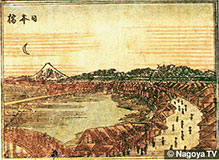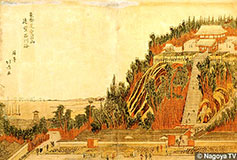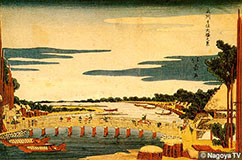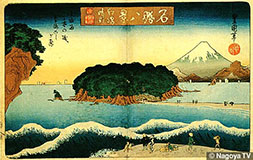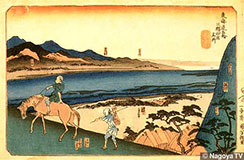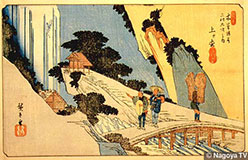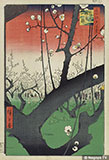作品一覧 風景
Landscape

浮絵東叡山中堂之図 葛飾北斎(かつしかほくさい ?-1849)
Uki-e of the Toeizan central hall Katsushika, Hokusai (?-1849)
上野の東叡山寛永寺を正面から堂々とした姿に描く。建物の直線を利用して、遠近感を強調した浮絵(うきえ)の手法を用いるのは、若き北斎。
A grand depiction from the front of Toeizan's Kan'ei Temple in Ueno. The young Hokusai applies an Ukie technique that utilizes the straight lines of the building, which emphasizes the perspective.
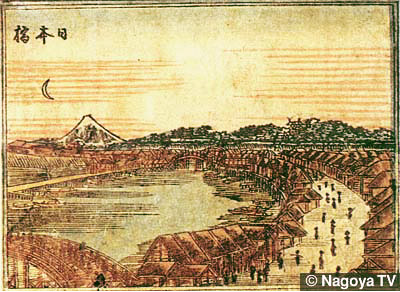
阿蘭陀画鏡江戸八景 日本橋 葛飾北斎(かつしかほくさい ?-1849)
Nihonbashi, from the series "Eight western style views of Edo" Katsushika, Hokusai (?-1849)
かつては日本橋から、江戸城ごしに富士山が見えたのであった。その様子を北斎は、銅版画のように細かな線描を多用した描写法でとらえる。
In the old days, Mt. Fuji could be seen from Nihonbashi towering behind Edo Castle. Hokusai captures this sight with a depiction method that utilizes the fine line drawings found in copper engraving.
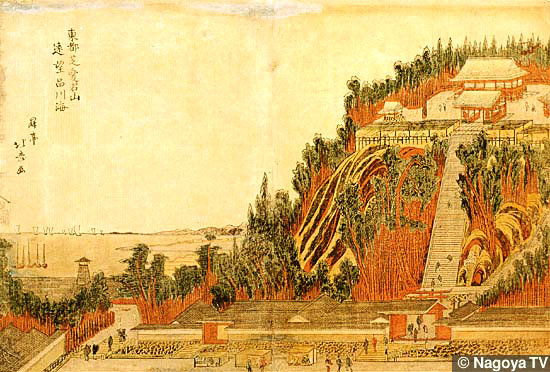
東都芝愛宕山遠望品川海 昇亭北寿(しょうていほくじゅ 18世紀末-19世紀初)
View of the Shinagawa bay from the foot of Atagoyama Shotei, Hokuju (the end of 18th century to the beginning of 19th century)
北寿は北斎の弟子。図は、芝の愛宕山の麓から、遠く品川の海を眺めるようすを描いている。山肌の奇妙な遠近法が印象的である。
Hokuju was an apprentice of Hokusai. The print is from the foot of Atagoyama in Shiba overlooking the Shinagawa Bay. The strange perspective of the mountain face is particularly striking.

武州千住大橋之景 昇亭北寿(しょうていほくじゅ 18世紀末-19世紀初)
The great bridge at Senju Shotei, Hokuju (the end of 18th century to the beginning of 19th century)
隅田川の千住大橋越しに下流を眺める。江戸から日光街道へ行く際、いよいよ江戸とお別れの気分が高まる郊外の地。奇妙な雲の表現が面白い。
A view from the Senju Ohashi Bridge over the Sumida River looking downstream. When one would travel the Nikko Kaido road from Edo to Nikko, it was in this suburban area where one would begin to sense urban Edo being left behind. The strange portrayal of the clouds is eye-catching.

名勝八景 江島晴嵐 二代歌川豊国(にだいうたがわとよくに 19世紀前半)
Enoshima, from the series "Thirty-six views of Mt. Fuji" Utagawa, Toyokuni 2nd (early 19th century)
江ノ島は、富士山が程良い大きさに見える所。砂浜と島と富士山、景の取り合わせも抜群。富士の端正な形と、手前の波の表現の対比が面白い。
Enoshima is famous for providing a view of Mt. Fuji in just the right proportions. The variety of landscapes, the sandy beach, the island, and Mt.Fuji, is predominant as well. The contrast between the exquisite figure of Mt. Fuji and the portrayal of the waves is interesting.
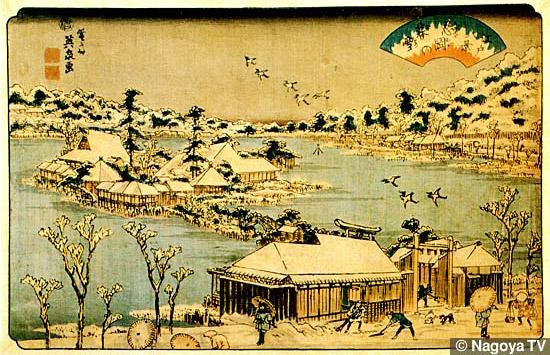
江戸八景 忍岡の暮雪 溪斎英泉(けいさいえいせん 1791-1848)
Snow overnight at Shinobugaoka from the series "Eight views of Edo" Keisai, Eisen (1791-1848)
上野の不忍の池に雪の積もった朝であろう、手前には雪かきの人々も見える。西洋の透視遠近法を意識した描写法である。
A wintry morning scene where snow has settled over Shinobazu Pond in Ueno. People can be seen in the foreground shoveling snow. A consciousness for western methods of clairvoyant perspective can clearly be seen in the depiction method.

江戸日本橋ヨリ富士ヲ見ル図 溪斎英泉(けいさいえいせん 1791-1848)
View of Mt. Fuji from Nihonbashi Keisai, Eisen (1791-1848)
日本橋から江戸城、そして遠く富士をのぞむ。連なる土蔵、参集する舟と、活況を呈す。周囲のアルファベット風文字は、洋風を狙ったもの。
From Nihonbashi to Edo Castle approaching the distant Mt. Fuji. The lifestyles are expressed through the line of warehouses and the gathering of boats. The alphabetical characters around the border are is an attempt to make it look western.

東海道五拾三駅四宿名所 岡部-金谷 歌川国芳(うたがわくによし 1797-1861)
Four stations of the Tokaido road Utagawa, Kuniyoshi (1797-1861)
東海道の53の宿場を、4・5駅ずつまとめた作。本図は静岡県内の4つの宿場がまとめられる。大井川を見ながら、山の坂道を登る様子である。
A print that has combined four or five stations from the 53 of the Tokaido Highway. Four stations in Shizuoka prefecture are being shown here. The travelers are climbing the sloping road while looking at the Oi River.
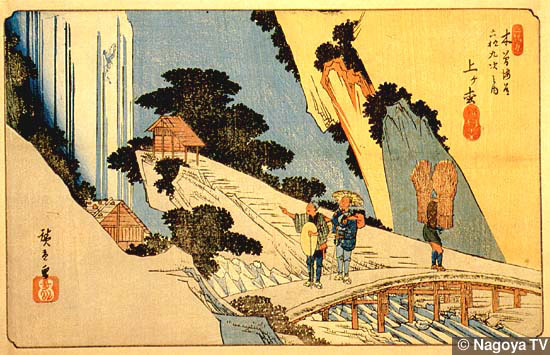
木曾街道六拾九次 上ケ松 歌川広重(うたがわひろしげ 1797-1858)
Agematsu, from the series "Sixty-nine stations of the Kisokaido" Utagawa, Hiroshige (1797-1858)
中山道の木曽地方の宿場上ケ松(あげまつ)付近での情景。橋の上ではついつい立ち止まってしまうもの。ましてや、滝などあれば申し分ない。
A sight near Agematsu station off of Nakasendo Highway in the Kiso area. We are often compelled stop in our steps when crossing a bridge to observe the view, especially in this picture where there is a waterfall.
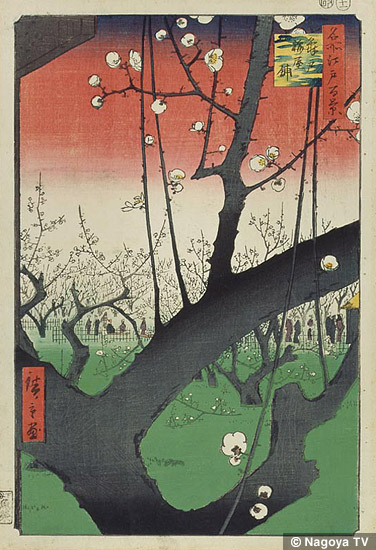
名所江戸百景 亀戸梅屋舗 歌川広重(うたがわひろしげ 1797-1858)
The plum blossom garden at Kameido, from the series "One hundred famous views of Edo" Utagawa, Hiroshige (1797-1858)
江戸の亀戸天神社の裏手の梅屋敷である。近くのものを視線を遮るかのように大きく描く手法は新鮮。ゴッホが模写したことでも有名な作である。
The plum blossom gardens of the Kameido Tenjin Shrine in Edo. The method of depicting largely, as if cutting off all lines of vision, is that of a new one. This piece is also famous for Vincent Van Gogh creating a reproduction of it.


































